Women representation and inclusion in the United Kingdom Assignment 2022
VerifiedAdded on 2022/10/01
|15
|2847
|29
Assignment
AI Summary
Topic: Representation and inclusion of women in the UK and European parliament: current state, policy and what more needs to be done? Sections Required: 1. literature review 2. research design ideas 3. argument outline Find Attached an example Research Proposal and guidelines as well.
Contribute Materials
Your contribution can guide someone’s learning journey. Share your
documents today.
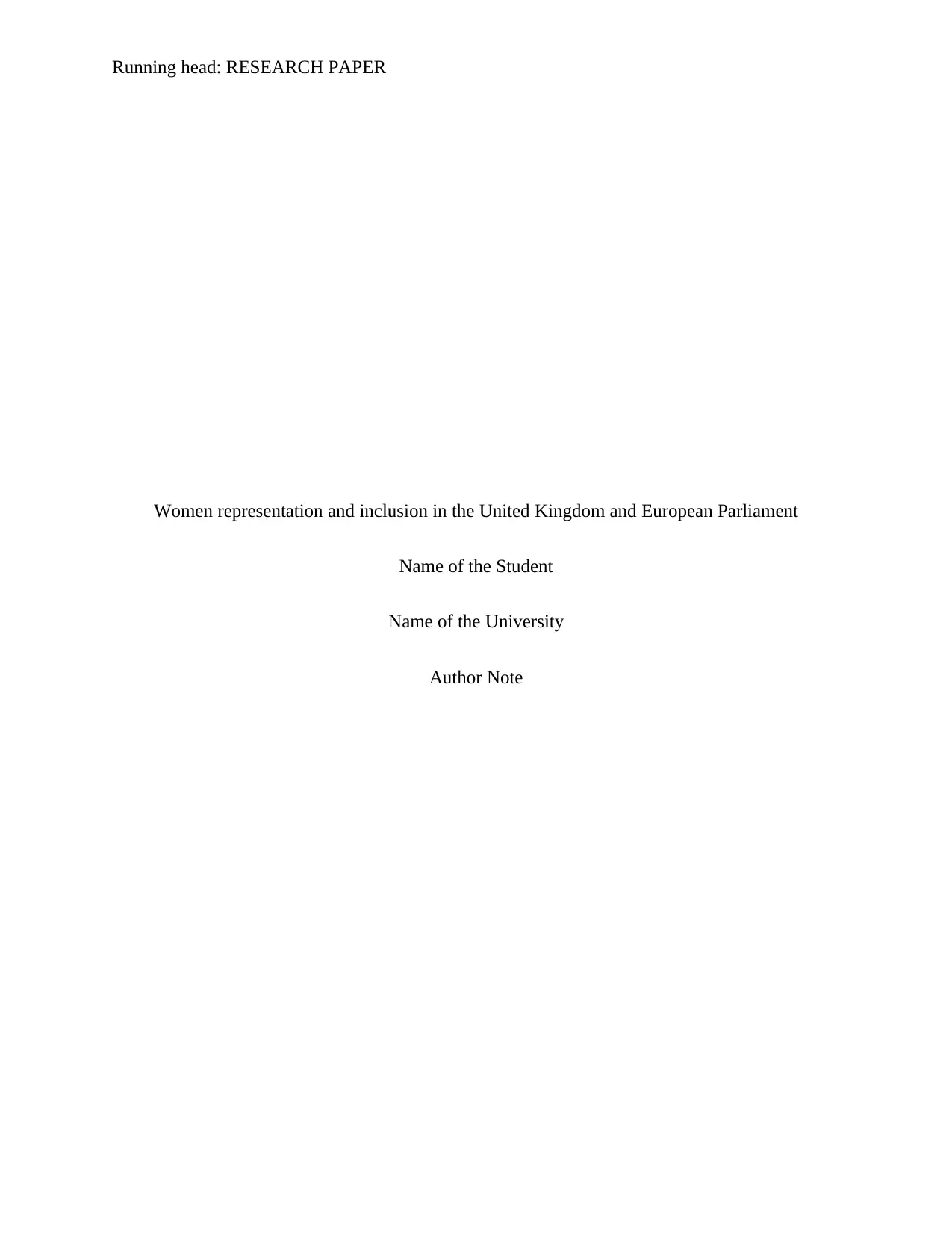
Running head: RESEARCH PAPER
Women representation and inclusion in the United Kingdom and European Parliament
Name of the Student
Name of the University
Author Note
Women representation and inclusion in the United Kingdom and European Parliament
Name of the Student
Name of the University
Author Note
Secure Best Marks with AI Grader
Need help grading? Try our AI Grader for instant feedback on your assignments.
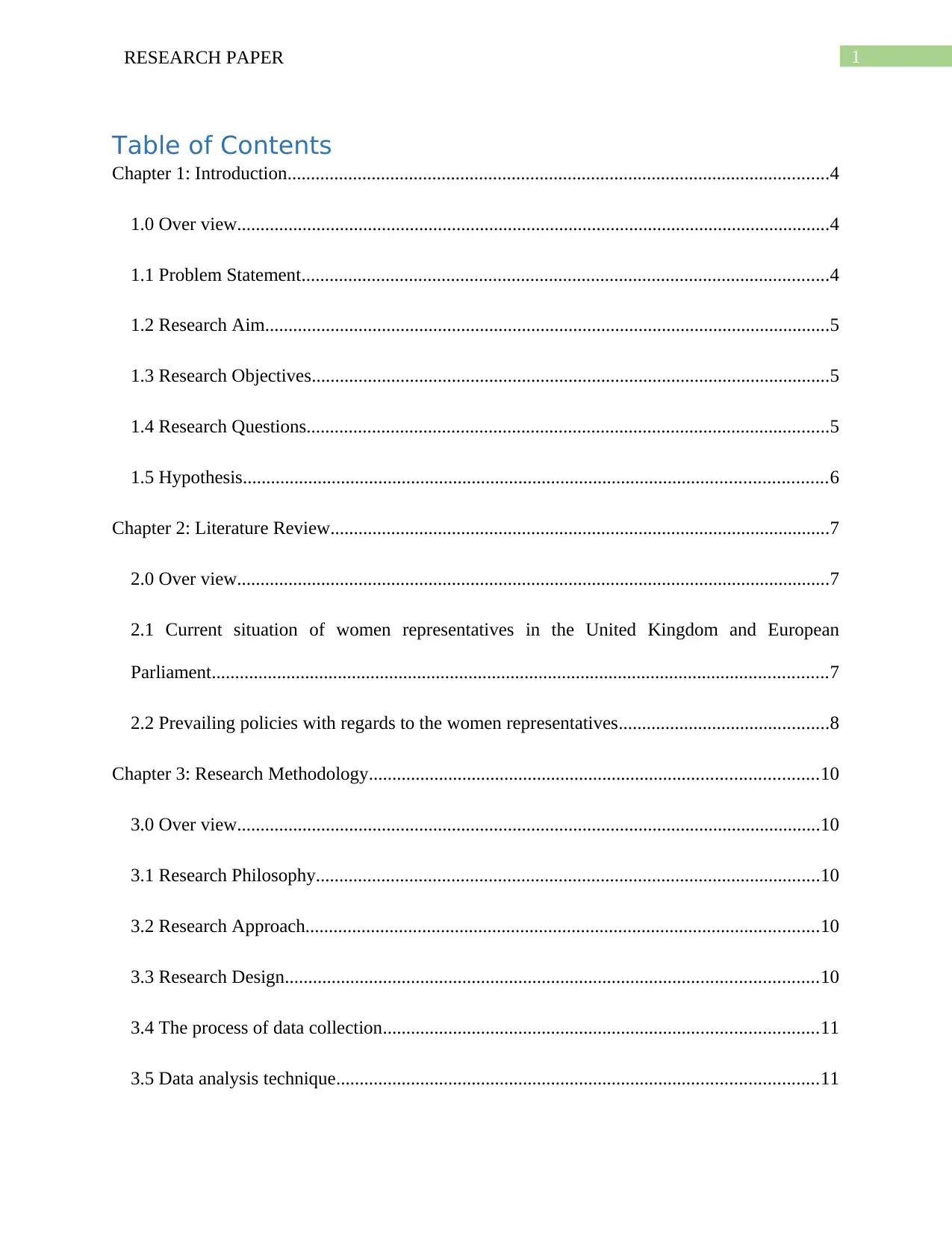
1RESEARCH PAPER
Table of Contents
Chapter 1: Introduction....................................................................................................................4
1.0 Over view...............................................................................................................................4
1.1 Problem Statement.................................................................................................................4
1.2 Research Aim.........................................................................................................................5
1.3 Research Objectives...............................................................................................................5
1.4 Research Questions................................................................................................................5
1.5 Hypothesis.............................................................................................................................6
Chapter 2: Literature Review...........................................................................................................7
2.0 Over view...............................................................................................................................7
2.1 Current situation of women representatives in the United Kingdom and European
Parliament....................................................................................................................................7
2.2 Prevailing policies with regards to the women representatives.............................................8
Chapter 3: Research Methodology................................................................................................10
3.0 Over view.............................................................................................................................10
3.1 Research Philosophy............................................................................................................10
3.2 Research Approach..............................................................................................................10
3.3 Research Design..................................................................................................................10
3.4 The process of data collection.............................................................................................11
3.5 Data analysis technique.......................................................................................................11
Table of Contents
Chapter 1: Introduction....................................................................................................................4
1.0 Over view...............................................................................................................................4
1.1 Problem Statement.................................................................................................................4
1.2 Research Aim.........................................................................................................................5
1.3 Research Objectives...............................................................................................................5
1.4 Research Questions................................................................................................................5
1.5 Hypothesis.............................................................................................................................6
Chapter 2: Literature Review...........................................................................................................7
2.0 Over view...............................................................................................................................7
2.1 Current situation of women representatives in the United Kingdom and European
Parliament....................................................................................................................................7
2.2 Prevailing policies with regards to the women representatives.............................................8
Chapter 3: Research Methodology................................................................................................10
3.0 Over view.............................................................................................................................10
3.1 Research Philosophy............................................................................................................10
3.2 Research Approach..............................................................................................................10
3.3 Research Design..................................................................................................................10
3.4 The process of data collection.............................................................................................11
3.5 Data analysis technique.......................................................................................................11

2RESEARCH PAPER
3.6 Ethical consideration...........................................................................................................11
3.7 Anticipated Findings............................................................................................................11
References:....................................................................................................................................13
3.6 Ethical consideration...........................................................................................................11
3.7 Anticipated Findings............................................................................................................11
References:....................................................................................................................................13
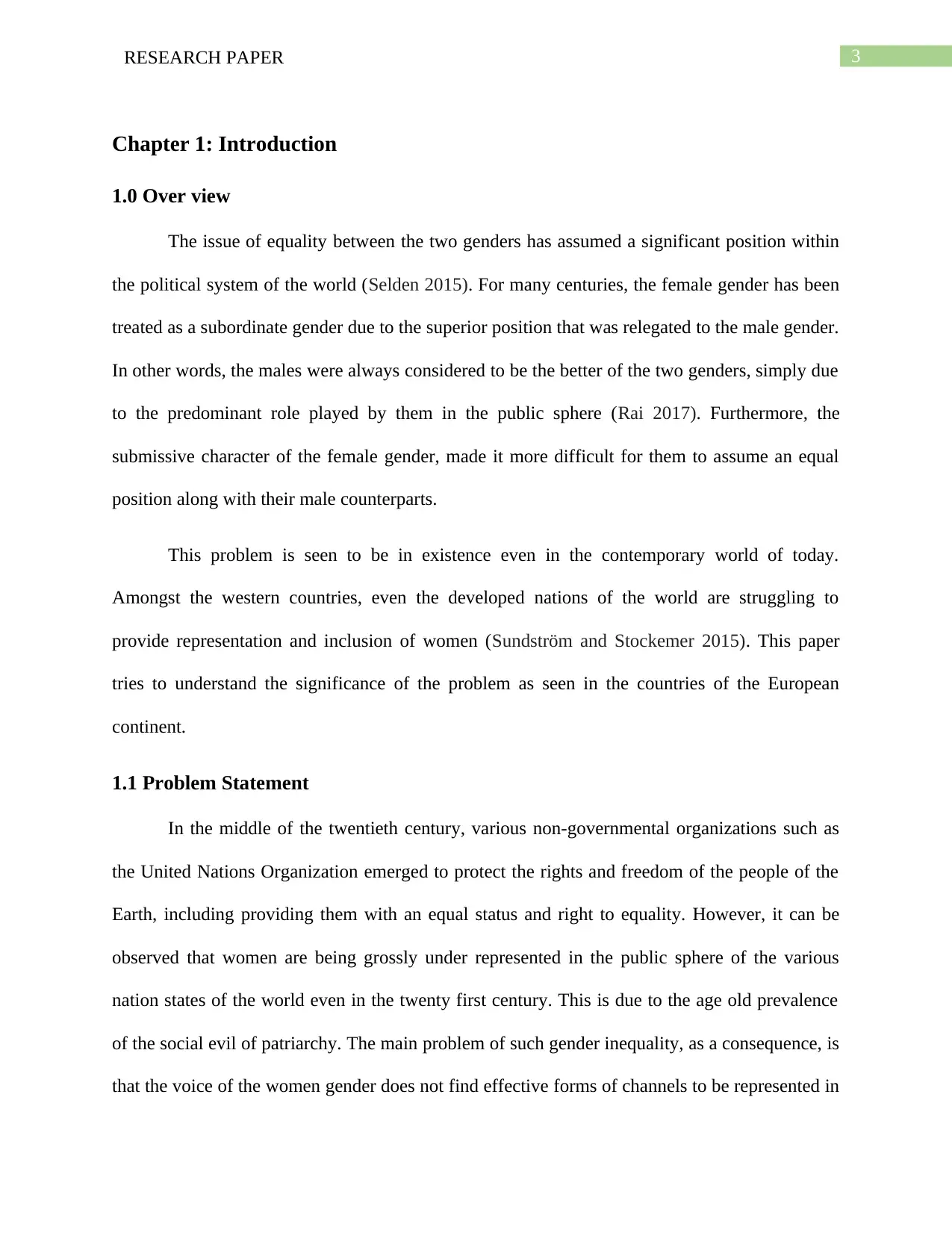
3RESEARCH PAPER
Chapter 1: Introduction
1.0 Over view
The issue of equality between the two genders has assumed a significant position within
the political system of the world (Selden 2015). For many centuries, the female gender has been
treated as a subordinate gender due to the superior position that was relegated to the male gender.
In other words, the males were always considered to be the better of the two genders, simply due
to the predominant role played by them in the public sphere (Rai 2017). Furthermore, the
submissive character of the female gender, made it more difficult for them to assume an equal
position along with their male counterparts.
This problem is seen to be in existence even in the contemporary world of today.
Amongst the western countries, even the developed nations of the world are struggling to
provide representation and inclusion of women (Sundström and Stockemer 2015). This paper
tries to understand the significance of the problem as seen in the countries of the European
continent.
1.1 Problem Statement
In the middle of the twentieth century, various non-governmental organizations such as
the United Nations Organization emerged to protect the rights and freedom of the people of the
Earth, including providing them with an equal status and right to equality. However, it can be
observed that women are being grossly under represented in the public sphere of the various
nation states of the world even in the twenty first century. This is due to the age old prevalence
of the social evil of patriarchy. The main problem of such gender inequality, as a consequence, is
that the voice of the women gender does not find effective forms of channels to be represented in
Chapter 1: Introduction
1.0 Over view
The issue of equality between the two genders has assumed a significant position within
the political system of the world (Selden 2015). For many centuries, the female gender has been
treated as a subordinate gender due to the superior position that was relegated to the male gender.
In other words, the males were always considered to be the better of the two genders, simply due
to the predominant role played by them in the public sphere (Rai 2017). Furthermore, the
submissive character of the female gender, made it more difficult for them to assume an equal
position along with their male counterparts.
This problem is seen to be in existence even in the contemporary world of today.
Amongst the western countries, even the developed nations of the world are struggling to
provide representation and inclusion of women (Sundström and Stockemer 2015). This paper
tries to understand the significance of the problem as seen in the countries of the European
continent.
1.1 Problem Statement
In the middle of the twentieth century, various non-governmental organizations such as
the United Nations Organization emerged to protect the rights and freedom of the people of the
Earth, including providing them with an equal status and right to equality. However, it can be
observed that women are being grossly under represented in the public sphere of the various
nation states of the world even in the twenty first century. This is due to the age old prevalence
of the social evil of patriarchy. The main problem of such gender inequality, as a consequence, is
that the voice of the women gender does not find effective forms of channels to be represented in
Secure Best Marks with AI Grader
Need help grading? Try our AI Grader for instant feedback on your assignments.
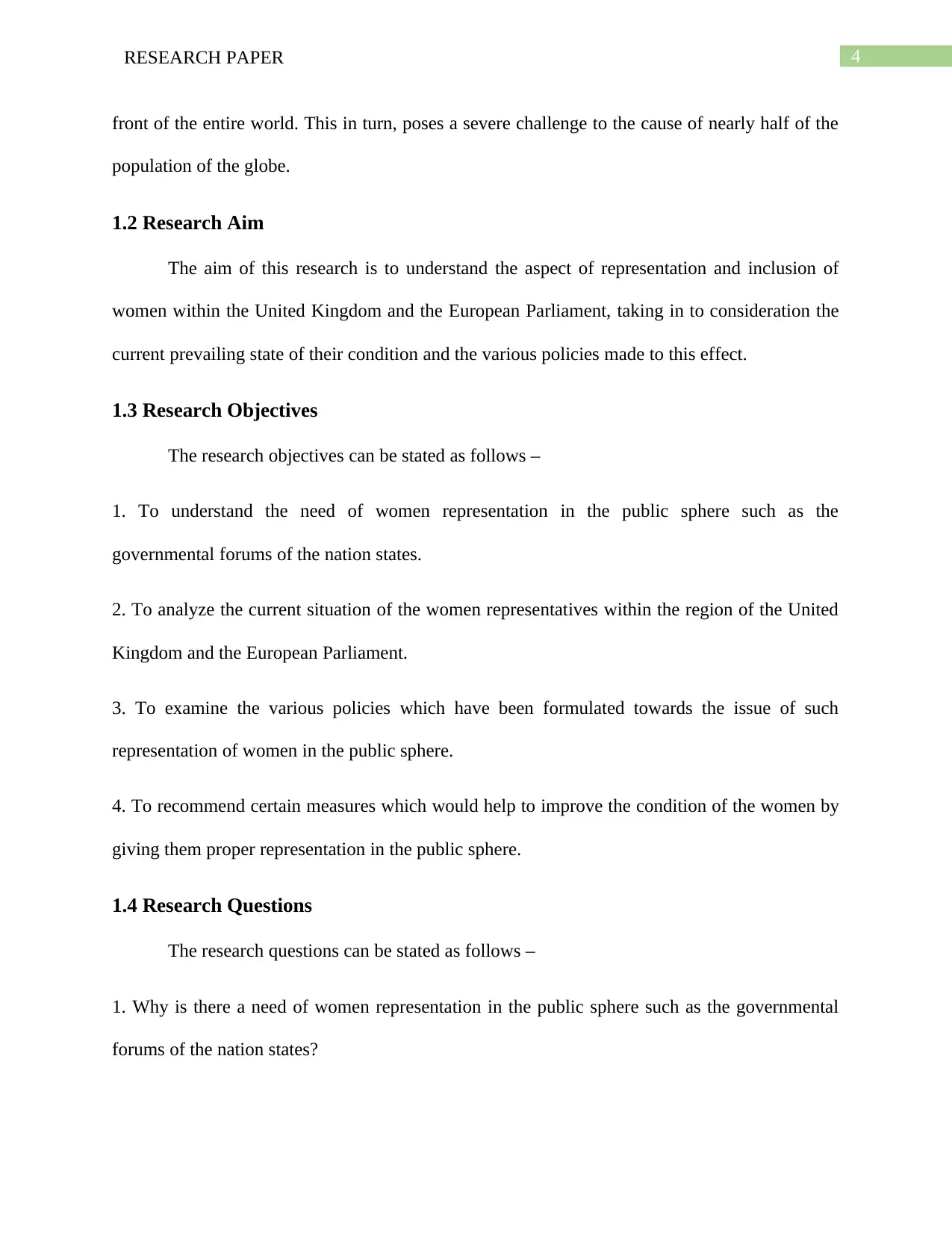
4RESEARCH PAPER
front of the entire world. This in turn, poses a severe challenge to the cause of nearly half of the
population of the globe.
1.2 Research Aim
The aim of this research is to understand the aspect of representation and inclusion of
women within the United Kingdom and the European Parliament, taking in to consideration the
current prevailing state of their condition and the various policies made to this effect.
1.3 Research Objectives
The research objectives can be stated as follows –
1. To understand the need of women representation in the public sphere such as the
governmental forums of the nation states.
2. To analyze the current situation of the women representatives within the region of the United
Kingdom and the European Parliament.
3. To examine the various policies which have been formulated towards the issue of such
representation of women in the public sphere.
4. To recommend certain measures which would help to improve the condition of the women by
giving them proper representation in the public sphere.
1.4 Research Questions
The research questions can be stated as follows –
1. Why is there a need of women representation in the public sphere such as the governmental
forums of the nation states?
front of the entire world. This in turn, poses a severe challenge to the cause of nearly half of the
population of the globe.
1.2 Research Aim
The aim of this research is to understand the aspect of representation and inclusion of
women within the United Kingdom and the European Parliament, taking in to consideration the
current prevailing state of their condition and the various policies made to this effect.
1.3 Research Objectives
The research objectives can be stated as follows –
1. To understand the need of women representation in the public sphere such as the
governmental forums of the nation states.
2. To analyze the current situation of the women representatives within the region of the United
Kingdom and the European Parliament.
3. To examine the various policies which have been formulated towards the issue of such
representation of women in the public sphere.
4. To recommend certain measures which would help to improve the condition of the women by
giving them proper representation in the public sphere.
1.4 Research Questions
The research questions can be stated as follows –
1. Why is there a need of women representation in the public sphere such as the governmental
forums of the nation states?
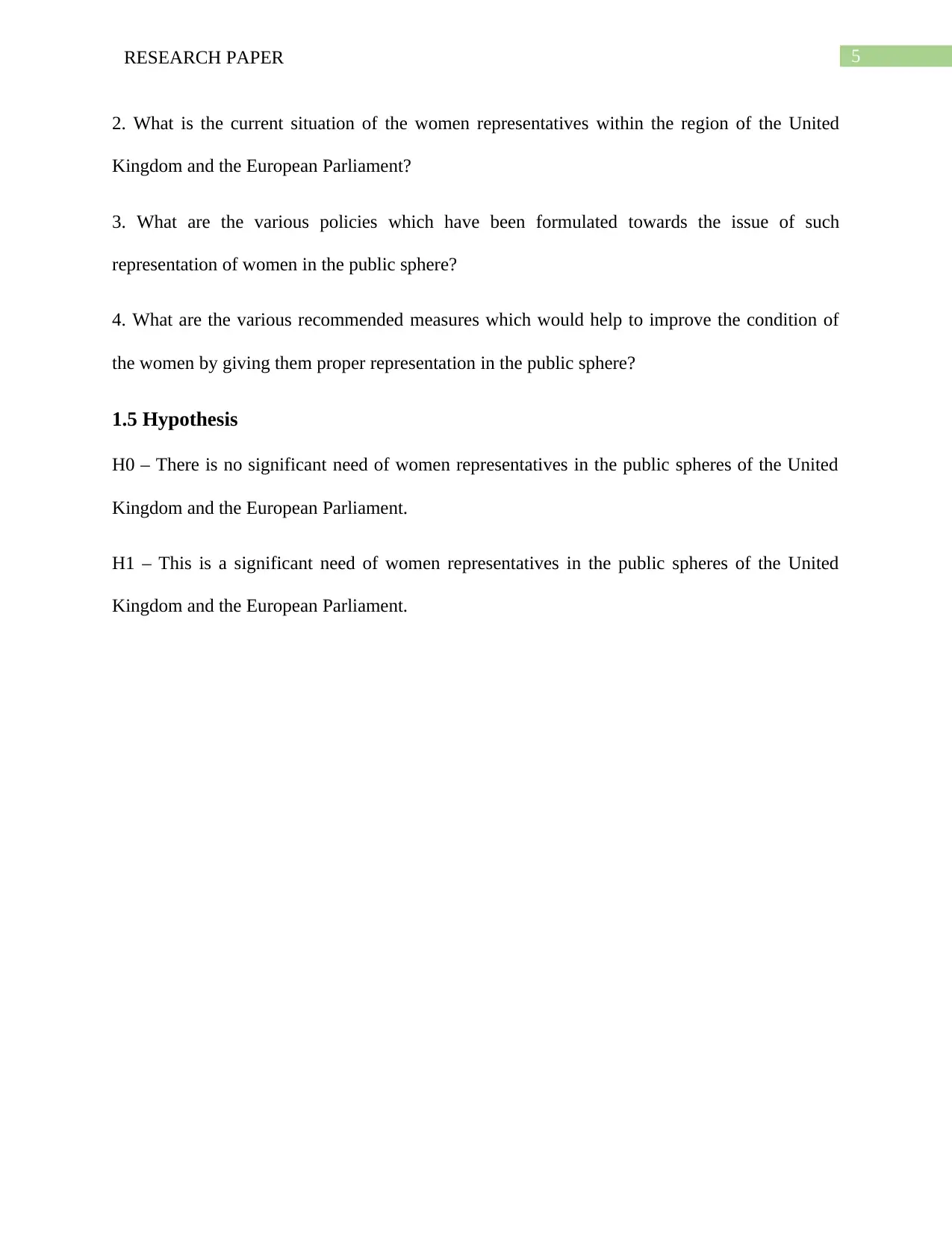
5RESEARCH PAPER
2. What is the current situation of the women representatives within the region of the United
Kingdom and the European Parliament?
3. What are the various policies which have been formulated towards the issue of such
representation of women in the public sphere?
4. What are the various recommended measures which would help to improve the condition of
the women by giving them proper representation in the public sphere?
1.5 Hypothesis
H0 – There is no significant need of women representatives in the public spheres of the United
Kingdom and the European Parliament.
H1 – This is a significant need of women representatives in the public spheres of the United
Kingdom and the European Parliament.
2. What is the current situation of the women representatives within the region of the United
Kingdom and the European Parliament?
3. What are the various policies which have been formulated towards the issue of such
representation of women in the public sphere?
4. What are the various recommended measures which would help to improve the condition of
the women by giving them proper representation in the public sphere?
1.5 Hypothesis
H0 – There is no significant need of women representatives in the public spheres of the United
Kingdom and the European Parliament.
H1 – This is a significant need of women representatives in the public spheres of the United
Kingdom and the European Parliament.
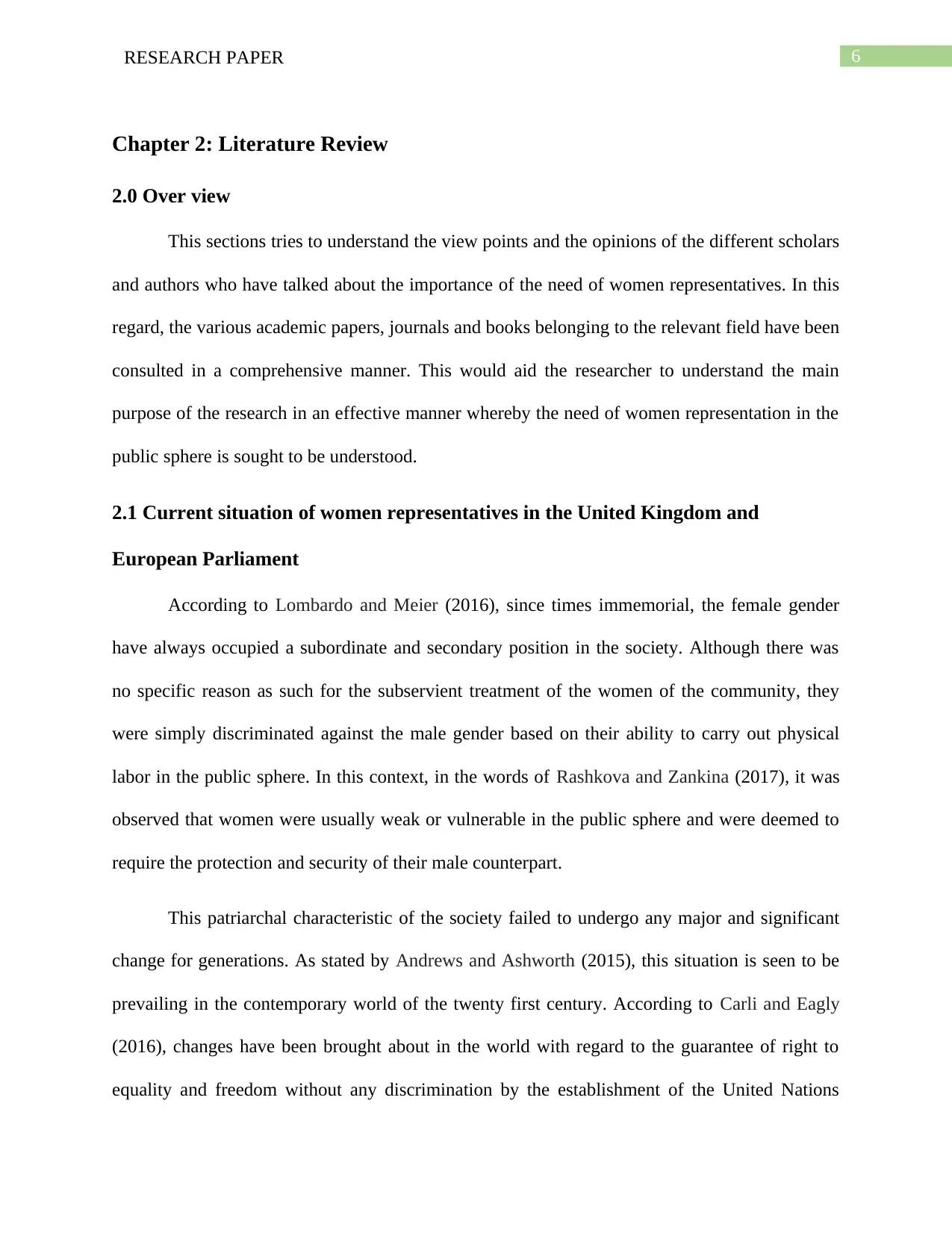
6RESEARCH PAPER
Chapter 2: Literature Review
2.0 Over view
This sections tries to understand the view points and the opinions of the different scholars
and authors who have talked about the importance of the need of women representatives. In this
regard, the various academic papers, journals and books belonging to the relevant field have been
consulted in a comprehensive manner. This would aid the researcher to understand the main
purpose of the research in an effective manner whereby the need of women representation in the
public sphere is sought to be understood.
2.1 Current situation of women representatives in the United Kingdom and
European Parliament
According to Lombardo and Meier (2016), since times immemorial, the female gender
have always occupied a subordinate and secondary position in the society. Although there was
no specific reason as such for the subservient treatment of the women of the community, they
were simply discriminated against the male gender based on their ability to carry out physical
labor in the public sphere. In this context, in the words of Rashkova and Zankina (2017), it was
observed that women were usually weak or vulnerable in the public sphere and were deemed to
require the protection and security of their male counterpart.
This patriarchal characteristic of the society failed to undergo any major and significant
change for generations. As stated by Andrews and Ashworth (2015), this situation is seen to be
prevailing in the contemporary world of the twenty first century. According to Carli and Eagly
(2016), changes have been brought about in the world with regard to the guarantee of right to
equality and freedom without any discrimination by the establishment of the United Nations
Chapter 2: Literature Review
2.0 Over view
This sections tries to understand the view points and the opinions of the different scholars
and authors who have talked about the importance of the need of women representatives. In this
regard, the various academic papers, journals and books belonging to the relevant field have been
consulted in a comprehensive manner. This would aid the researcher to understand the main
purpose of the research in an effective manner whereby the need of women representation in the
public sphere is sought to be understood.
2.1 Current situation of women representatives in the United Kingdom and
European Parliament
According to Lombardo and Meier (2016), since times immemorial, the female gender
have always occupied a subordinate and secondary position in the society. Although there was
no specific reason as such for the subservient treatment of the women of the community, they
were simply discriminated against the male gender based on their ability to carry out physical
labor in the public sphere. In this context, in the words of Rashkova and Zankina (2017), it was
observed that women were usually weak or vulnerable in the public sphere and were deemed to
require the protection and security of their male counterpart.
This patriarchal characteristic of the society failed to undergo any major and significant
change for generations. As stated by Andrews and Ashworth (2015), this situation is seen to be
prevailing in the contemporary world of the twenty first century. According to Carli and Eagly
(2016), changes have been brought about in the world with regard to the guarantee of right to
equality and freedom without any discrimination by the establishment of the United Nations
Paraphrase This Document
Need a fresh take? Get an instant paraphrase of this document with our AI Paraphraser
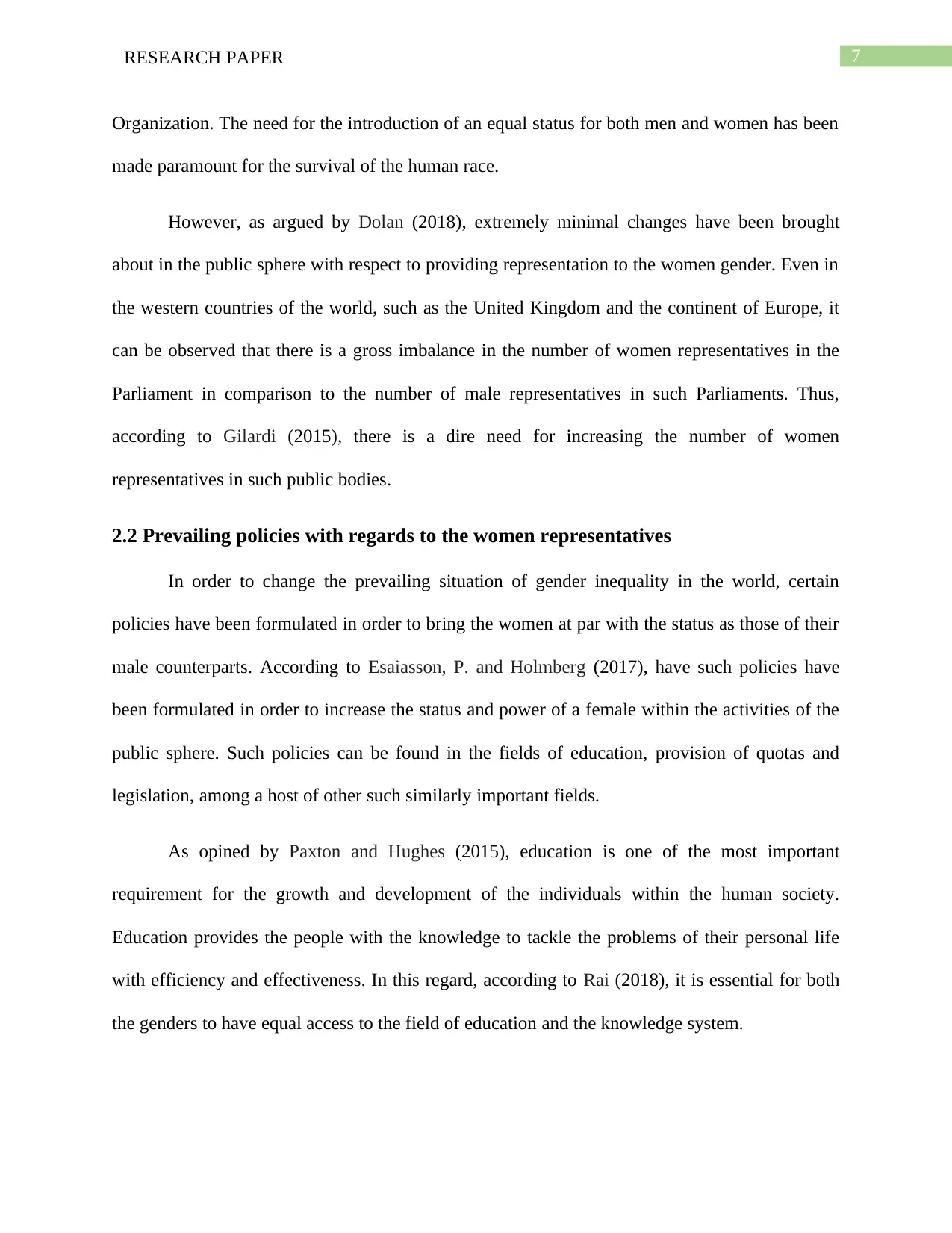
7RESEARCH PAPER
Organization. The need for the introduction of an equal status for both men and women has been
made paramount for the survival of the human race.
However, as argued by Dolan (2018), extremely minimal changes have been brought
about in the public sphere with respect to providing representation to the women gender. Even in
the western countries of the world, such as the United Kingdom and the continent of Europe, it
can be observed that there is a gross imbalance in the number of women representatives in the
Parliament in comparison to the number of male representatives in such Parliaments. Thus,
according to Gilardi (2015), there is a dire need for increasing the number of women
representatives in such public bodies.
2.2 Prevailing policies with regards to the women representatives
In order to change the prevailing situation of gender inequality in the world, certain
policies have been formulated in order to bring the women at par with the status as those of their
male counterparts. According to Esaiasson, P. and Holmberg (2017), have such policies have
been formulated in order to increase the status and power of a female within the activities of the
public sphere. Such policies can be found in the fields of education, provision of quotas and
legislation, among a host of other such similarly important fields.
As opined by Paxton and Hughes (2015), education is one of the most important
requirement for the growth and development of the individuals within the human society.
Education provides the people with the knowledge to tackle the problems of their personal life
with efficiency and effectiveness. In this regard, according to Rai (2018), it is essential for both
the genders to have equal access to the field of education and the knowledge system.
Organization. The need for the introduction of an equal status for both men and women has been
made paramount for the survival of the human race.
However, as argued by Dolan (2018), extremely minimal changes have been brought
about in the public sphere with respect to providing representation to the women gender. Even in
the western countries of the world, such as the United Kingdom and the continent of Europe, it
can be observed that there is a gross imbalance in the number of women representatives in the
Parliament in comparison to the number of male representatives in such Parliaments. Thus,
according to Gilardi (2015), there is a dire need for increasing the number of women
representatives in such public bodies.
2.2 Prevailing policies with regards to the women representatives
In order to change the prevailing situation of gender inequality in the world, certain
policies have been formulated in order to bring the women at par with the status as those of their
male counterparts. According to Esaiasson, P. and Holmberg (2017), have such policies have
been formulated in order to increase the status and power of a female within the activities of the
public sphere. Such policies can be found in the fields of education, provision of quotas and
legislation, among a host of other such similarly important fields.
As opined by Paxton and Hughes (2015), education is one of the most important
requirement for the growth and development of the individuals within the human society.
Education provides the people with the knowledge to tackle the problems of their personal life
with efficiency and effectiveness. In this regard, according to Rai (2018), it is essential for both
the genders to have equal access to the field of education and the knowledge system.
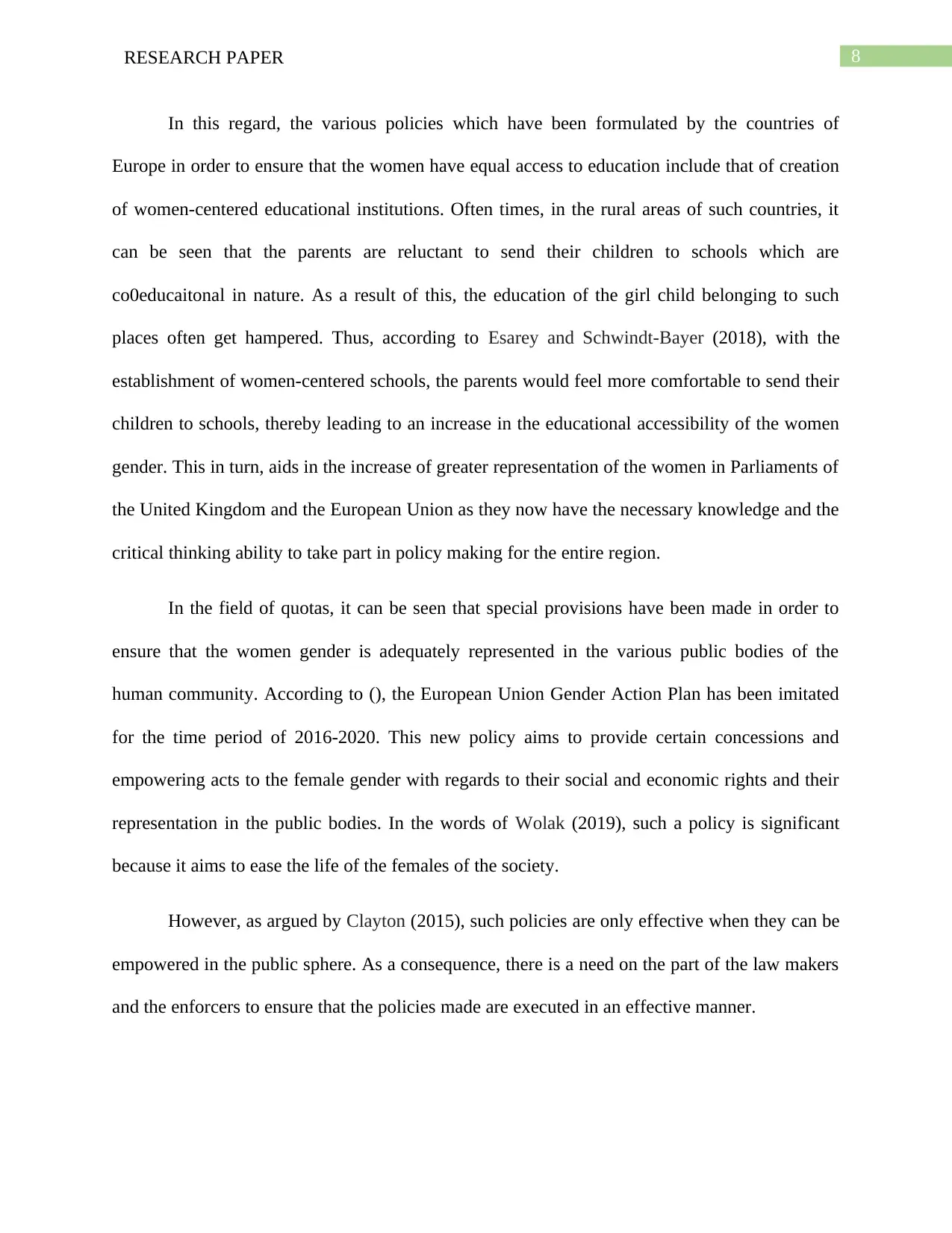
8RESEARCH PAPER
In this regard, the various policies which have been formulated by the countries of
Europe in order to ensure that the women have equal access to education include that of creation
of women-centered educational institutions. Often times, in the rural areas of such countries, it
can be seen that the parents are reluctant to send their children to schools which are
co0educaitonal in nature. As a result of this, the education of the girl child belonging to such
places often get hampered. Thus, according to Esarey and Schwindt-Bayer (2018), with the
establishment of women-centered schools, the parents would feel more comfortable to send their
children to schools, thereby leading to an increase in the educational accessibility of the women
gender. This in turn, aids in the increase of greater representation of the women in Parliaments of
the United Kingdom and the European Union as they now have the necessary knowledge and the
critical thinking ability to take part in policy making for the entire region.
In the field of quotas, it can be seen that special provisions have been made in order to
ensure that the women gender is adequately represented in the various public bodies of the
human community. According to (), the European Union Gender Action Plan has been imitated
for the time period of 2016-2020. This new policy aims to provide certain concessions and
empowering acts to the female gender with regards to their social and economic rights and their
representation in the public bodies. In the words of Wolak (2019), such a policy is significant
because it aims to ease the life of the females of the society.
However, as argued by Clayton (2015), such policies are only effective when they can be
empowered in the public sphere. As a consequence, there is a need on the part of the law makers
and the enforcers to ensure that the policies made are executed in an effective manner.
In this regard, the various policies which have been formulated by the countries of
Europe in order to ensure that the women have equal access to education include that of creation
of women-centered educational institutions. Often times, in the rural areas of such countries, it
can be seen that the parents are reluctant to send their children to schools which are
co0educaitonal in nature. As a result of this, the education of the girl child belonging to such
places often get hampered. Thus, according to Esarey and Schwindt-Bayer (2018), with the
establishment of women-centered schools, the parents would feel more comfortable to send their
children to schools, thereby leading to an increase in the educational accessibility of the women
gender. This in turn, aids in the increase of greater representation of the women in Parliaments of
the United Kingdom and the European Union as they now have the necessary knowledge and the
critical thinking ability to take part in policy making for the entire region.
In the field of quotas, it can be seen that special provisions have been made in order to
ensure that the women gender is adequately represented in the various public bodies of the
human community. According to (), the European Union Gender Action Plan has been imitated
for the time period of 2016-2020. This new policy aims to provide certain concessions and
empowering acts to the female gender with regards to their social and economic rights and their
representation in the public bodies. In the words of Wolak (2019), such a policy is significant
because it aims to ease the life of the females of the society.
However, as argued by Clayton (2015), such policies are only effective when they can be
empowered in the public sphere. As a consequence, there is a need on the part of the law makers
and the enforcers to ensure that the policies made are executed in an effective manner.
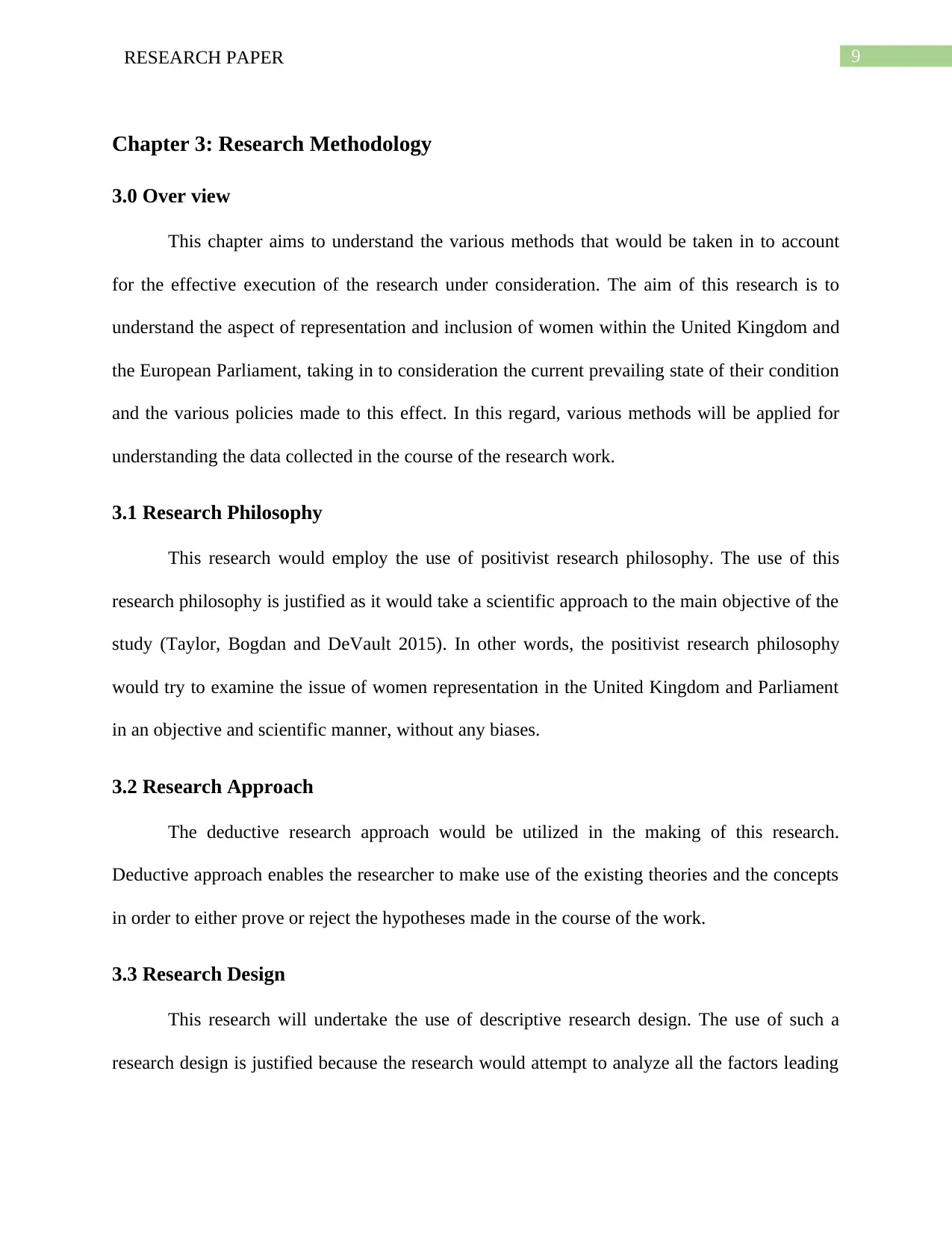
9RESEARCH PAPER
Chapter 3: Research Methodology
3.0 Over view
This chapter aims to understand the various methods that would be taken in to account
for the effective execution of the research under consideration. The aim of this research is to
understand the aspect of representation and inclusion of women within the United Kingdom and
the European Parliament, taking in to consideration the current prevailing state of their condition
and the various policies made to this effect. In this regard, various methods will be applied for
understanding the data collected in the course of the research work.
3.1 Research Philosophy
This research would employ the use of positivist research philosophy. The use of this
research philosophy is justified as it would take a scientific approach to the main objective of the
study (Taylor, Bogdan and DeVault 2015). In other words, the positivist research philosophy
would try to examine the issue of women representation in the United Kingdom and Parliament
in an objective and scientific manner, without any biases.
3.2 Research Approach
The deductive research approach would be utilized in the making of this research.
Deductive approach enables the researcher to make use of the existing theories and the concepts
in order to either prove or reject the hypotheses made in the course of the work.
3.3 Research Design
This research will undertake the use of descriptive research design. The use of such a
research design is justified because the research would attempt to analyze all the factors leading
Chapter 3: Research Methodology
3.0 Over view
This chapter aims to understand the various methods that would be taken in to account
for the effective execution of the research under consideration. The aim of this research is to
understand the aspect of representation and inclusion of women within the United Kingdom and
the European Parliament, taking in to consideration the current prevailing state of their condition
and the various policies made to this effect. In this regard, various methods will be applied for
understanding the data collected in the course of the research work.
3.1 Research Philosophy
This research would employ the use of positivist research philosophy. The use of this
research philosophy is justified as it would take a scientific approach to the main objective of the
study (Taylor, Bogdan and DeVault 2015). In other words, the positivist research philosophy
would try to examine the issue of women representation in the United Kingdom and Parliament
in an objective and scientific manner, without any biases.
3.2 Research Approach
The deductive research approach would be utilized in the making of this research.
Deductive approach enables the researcher to make use of the existing theories and the concepts
in order to either prove or reject the hypotheses made in the course of the work.
3.3 Research Design
This research will undertake the use of descriptive research design. The use of such a
research design is justified because the research would attempt to analyze all the factors leading
Secure Best Marks with AI Grader
Need help grading? Try our AI Grader for instant feedback on your assignments.
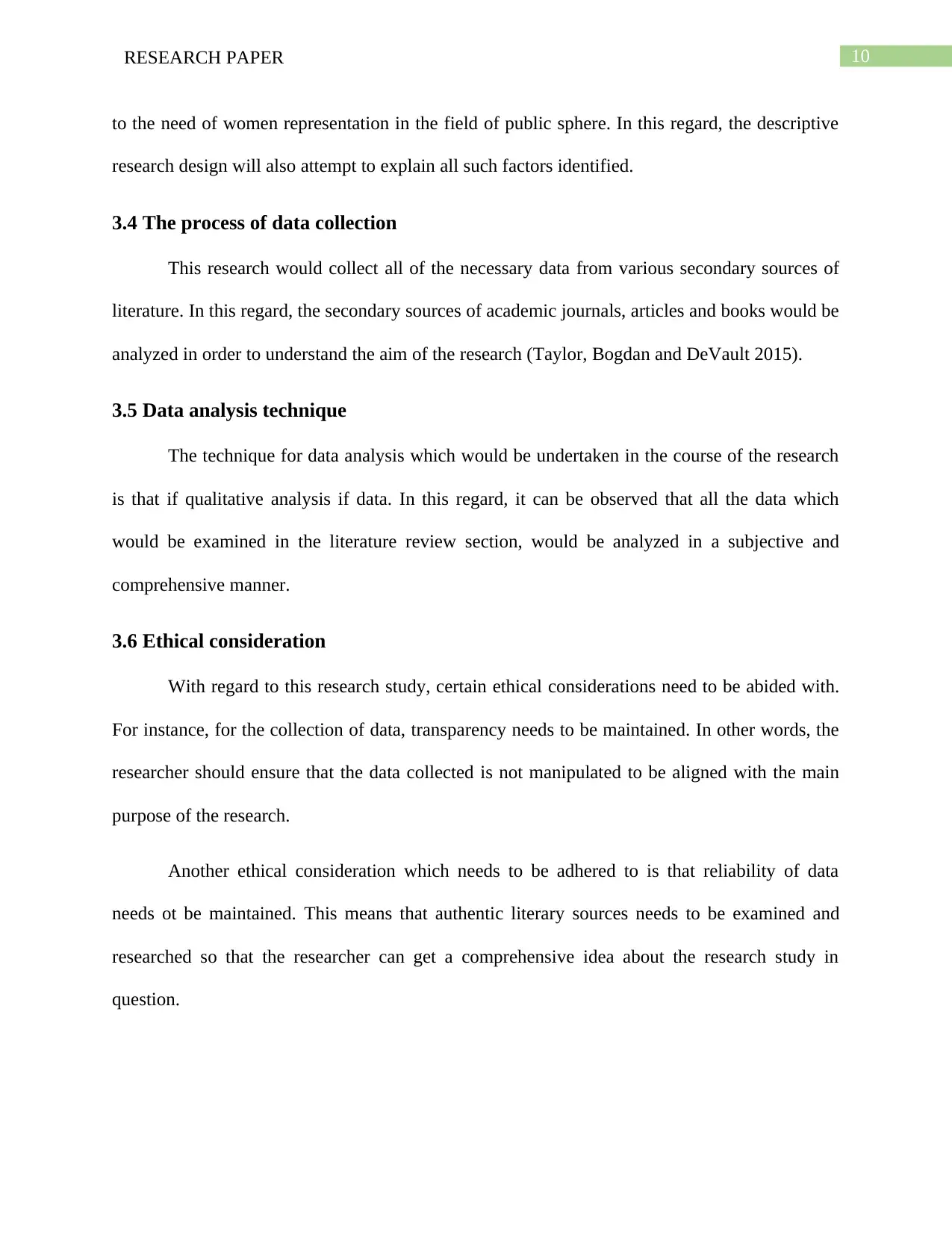
10RESEARCH PAPER
to the need of women representation in the field of public sphere. In this regard, the descriptive
research design will also attempt to explain all such factors identified.
3.4 The process of data collection
This research would collect all of the necessary data from various secondary sources of
literature. In this regard, the secondary sources of academic journals, articles and books would be
analyzed in order to understand the aim of the research (Taylor, Bogdan and DeVault 2015).
3.5 Data analysis technique
The technique for data analysis which would be undertaken in the course of the research
is that if qualitative analysis if data. In this regard, it can be observed that all the data which
would be examined in the literature review section, would be analyzed in a subjective and
comprehensive manner.
3.6 Ethical consideration
With regard to this research study, certain ethical considerations need to be abided with.
For instance, for the collection of data, transparency needs to be maintained. In other words, the
researcher should ensure that the data collected is not manipulated to be aligned with the main
purpose of the research.
Another ethical consideration which needs to be adhered to is that reliability of data
needs ot be maintained. This means that authentic literary sources needs to be examined and
researched so that the researcher can get a comprehensive idea about the research study in
question.
to the need of women representation in the field of public sphere. In this regard, the descriptive
research design will also attempt to explain all such factors identified.
3.4 The process of data collection
This research would collect all of the necessary data from various secondary sources of
literature. In this regard, the secondary sources of academic journals, articles and books would be
analyzed in order to understand the aim of the research (Taylor, Bogdan and DeVault 2015).
3.5 Data analysis technique
The technique for data analysis which would be undertaken in the course of the research
is that if qualitative analysis if data. In this regard, it can be observed that all the data which
would be examined in the literature review section, would be analyzed in a subjective and
comprehensive manner.
3.6 Ethical consideration
With regard to this research study, certain ethical considerations need to be abided with.
For instance, for the collection of data, transparency needs to be maintained. In other words, the
researcher should ensure that the data collected is not manipulated to be aligned with the main
purpose of the research.
Another ethical consideration which needs to be adhered to is that reliability of data
needs ot be maintained. This means that authentic literary sources needs to be examined and
researched so that the researcher can get a comprehensive idea about the research study in
question.
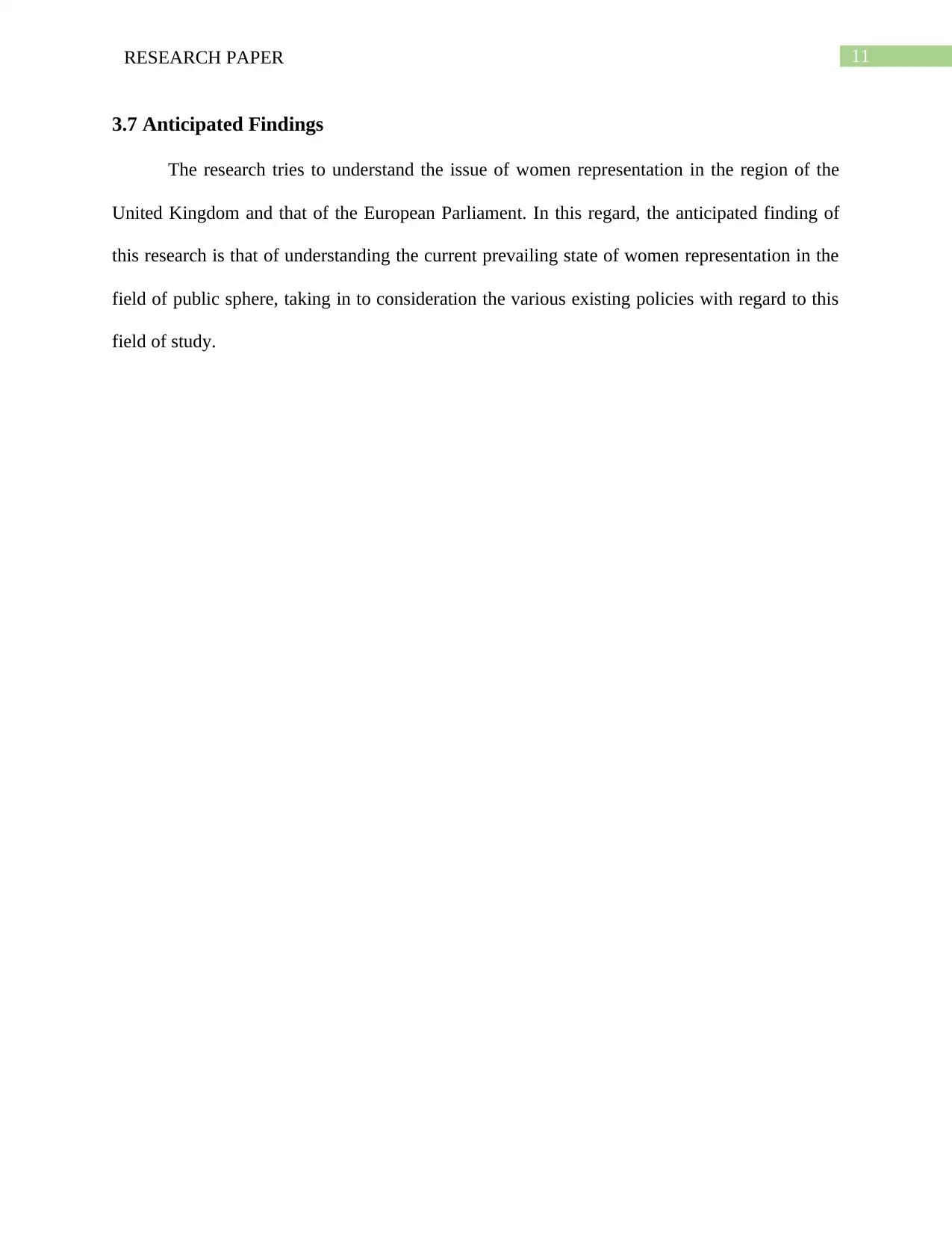
11RESEARCH PAPER
3.7 Anticipated Findings
The research tries to understand the issue of women representation in the region of the
United Kingdom and that of the European Parliament. In this regard, the anticipated finding of
this research is that of understanding the current prevailing state of women representation in the
field of public sphere, taking in to consideration the various existing policies with regard to this
field of study.
3.7 Anticipated Findings
The research tries to understand the issue of women representation in the region of the
United Kingdom and that of the European Parliament. In this regard, the anticipated finding of
this research is that of understanding the current prevailing state of women representation in the
field of public sphere, taking in to consideration the various existing policies with regard to this
field of study.
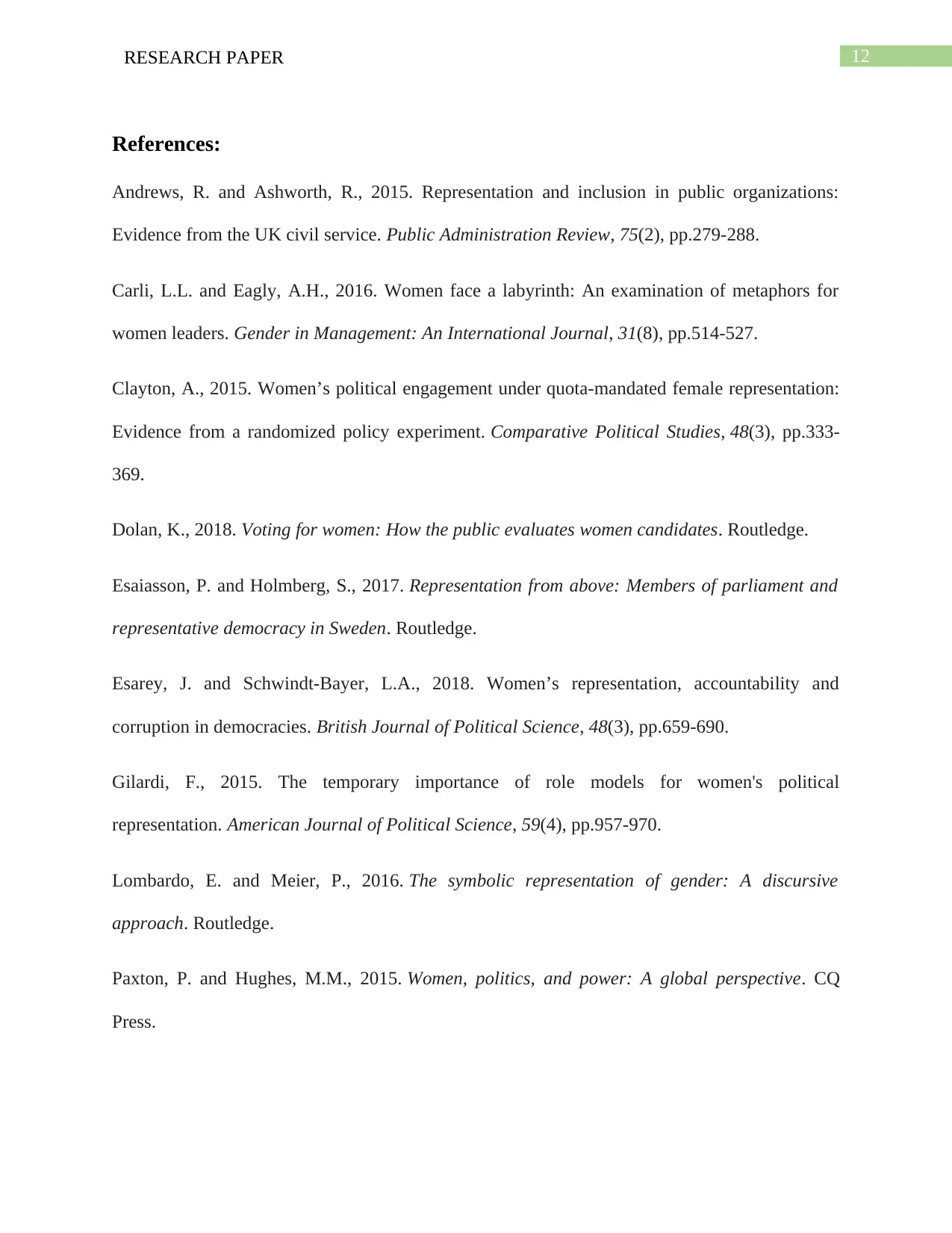
12RESEARCH PAPER
References:
Andrews, R. and Ashworth, R., 2015. Representation and inclusion in public organizations:
Evidence from the UK civil service. Public Administration Review, 75(2), pp.279-288.
Carli, L.L. and Eagly, A.H., 2016. Women face a labyrinth: An examination of metaphors for
women leaders. Gender in Management: An International Journal, 31(8), pp.514-527.
Clayton, A., 2015. Women’s political engagement under quota-mandated female representation:
Evidence from a randomized policy experiment. Comparative Political Studies, 48(3), pp.333-
369.
Dolan, K., 2018. Voting for women: How the public evaluates women candidates. Routledge.
Esaiasson, P. and Holmberg, S., 2017. Representation from above: Members of parliament and
representative democracy in Sweden. Routledge.
Esarey, J. and Schwindt-Bayer, L.A., 2018. Women’s representation, accountability and
corruption in democracies. British Journal of Political Science, 48(3), pp.659-690.
Gilardi, F., 2015. The temporary importance of role models for women's political
representation. American Journal of Political Science, 59(4), pp.957-970.
Lombardo, E. and Meier, P., 2016. The symbolic representation of gender: A discursive
approach. Routledge.
Paxton, P. and Hughes, M.M., 2015. Women, politics, and power: A global perspective. CQ
Press.
References:
Andrews, R. and Ashworth, R., 2015. Representation and inclusion in public organizations:
Evidence from the UK civil service. Public Administration Review, 75(2), pp.279-288.
Carli, L.L. and Eagly, A.H., 2016. Women face a labyrinth: An examination of metaphors for
women leaders. Gender in Management: An International Journal, 31(8), pp.514-527.
Clayton, A., 2015. Women’s political engagement under quota-mandated female representation:
Evidence from a randomized policy experiment. Comparative Political Studies, 48(3), pp.333-
369.
Dolan, K., 2018. Voting for women: How the public evaluates women candidates. Routledge.
Esaiasson, P. and Holmberg, S., 2017. Representation from above: Members of parliament and
representative democracy in Sweden. Routledge.
Esarey, J. and Schwindt-Bayer, L.A., 2018. Women’s representation, accountability and
corruption in democracies. British Journal of Political Science, 48(3), pp.659-690.
Gilardi, F., 2015. The temporary importance of role models for women's political
representation. American Journal of Political Science, 59(4), pp.957-970.
Lombardo, E. and Meier, P., 2016. The symbolic representation of gender: A discursive
approach. Routledge.
Paxton, P. and Hughes, M.M., 2015. Women, politics, and power: A global perspective. CQ
Press.
Paraphrase This Document
Need a fresh take? Get an instant paraphrase of this document with our AI Paraphraser
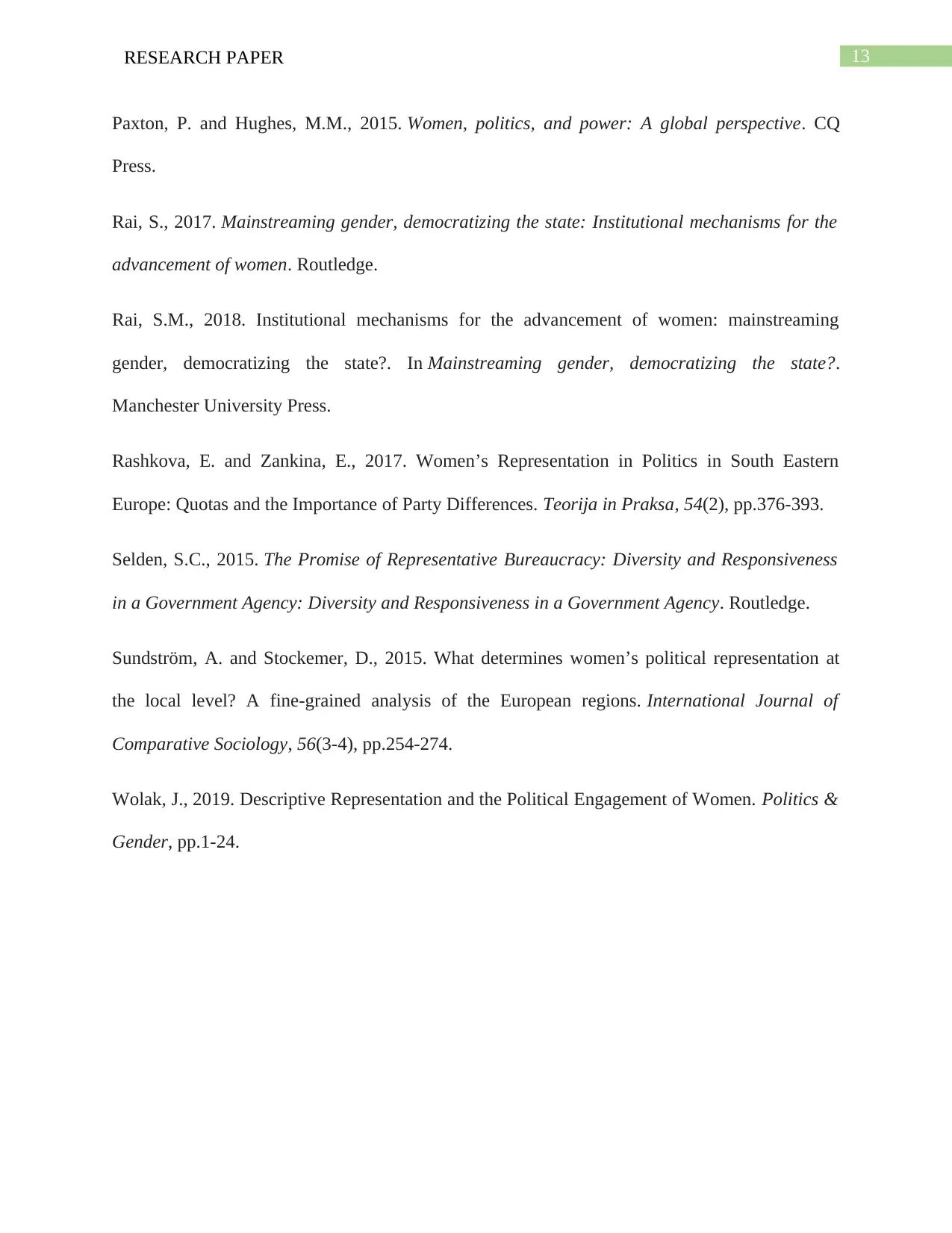
13RESEARCH PAPER
Paxton, P. and Hughes, M.M., 2015. Women, politics, and power: A global perspective. CQ
Press.
Rai, S., 2017. Mainstreaming gender, democratizing the state: Institutional mechanisms for the
advancement of women. Routledge.
Rai, S.M., 2018. Institutional mechanisms for the advancement of women: mainstreaming
gender, democratizing the state?. In Mainstreaming gender, democratizing the state?.
Manchester University Press.
Rashkova, E. and Zankina, E., 2017. Women’s Representation in Politics in South Eastern
Europe: Quotas and the Importance of Party Differences. Teorija in Praksa, 54(2), pp.376-393.
Selden, S.C., 2015. The Promise of Representative Bureaucracy: Diversity and Responsiveness
in a Government Agency: Diversity and Responsiveness in a Government Agency. Routledge.
Sundström, A. and Stockemer, D., 2015. What determines women’s political representation at
the local level? A fine-grained analysis of the European regions. International Journal of
Comparative Sociology, 56(3-4), pp.254-274.
Wolak, J., 2019. Descriptive Representation and the Political Engagement of Women. Politics &
Gender, pp.1-24.
Paxton, P. and Hughes, M.M., 2015. Women, politics, and power: A global perspective. CQ
Press.
Rai, S., 2017. Mainstreaming gender, democratizing the state: Institutional mechanisms for the
advancement of women. Routledge.
Rai, S.M., 2018. Institutional mechanisms for the advancement of women: mainstreaming
gender, democratizing the state?. In Mainstreaming gender, democratizing the state?.
Manchester University Press.
Rashkova, E. and Zankina, E., 2017. Women’s Representation in Politics in South Eastern
Europe: Quotas and the Importance of Party Differences. Teorija in Praksa, 54(2), pp.376-393.
Selden, S.C., 2015. The Promise of Representative Bureaucracy: Diversity and Responsiveness
in a Government Agency: Diversity and Responsiveness in a Government Agency. Routledge.
Sundström, A. and Stockemer, D., 2015. What determines women’s political representation at
the local level? A fine-grained analysis of the European regions. International Journal of
Comparative Sociology, 56(3-4), pp.254-274.
Wolak, J., 2019. Descriptive Representation and the Political Engagement of Women. Politics &
Gender, pp.1-24.

14RESEARCH PAPER
1 out of 15
Related Documents
Your All-in-One AI-Powered Toolkit for Academic Success.
+13062052269
info@desklib.com
Available 24*7 on WhatsApp / Email
![[object Object]](/_next/static/media/star-bottom.7253800d.svg)
Unlock your academic potential
© 2024 | Zucol Services PVT LTD | All rights reserved.





